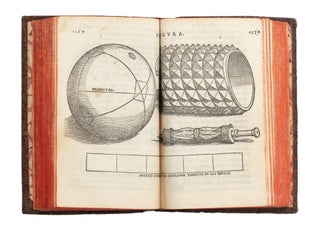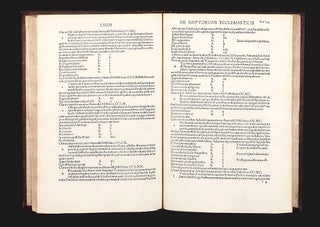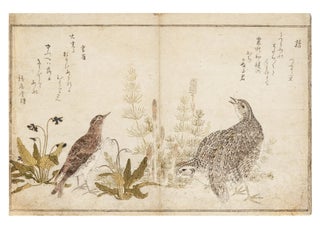“Priceless Records of the Earlier Stages of the Chinese Language”
What Did It Sound Like?
INKYO 韻鏡 [in Chinese: Yunjing; Mirror of Rhymes].
11 columns per page, 20 characters per column. Written in Chinese with manuscript Japanese reading marks. 52 folding leaves. Large 8vo (290 x 205 mm.), orig. wrappers (wrappers somewhat worn & rubbed), manuscript title-label on upper cover, new stitching. From the colophon: “Kyoto: Kotetsu shoin, 1608.”
A very rare movable type edition — not in WorldCat or NIJL — of one of the “two priceless records of the earlier stages of the Chinese language.”–Edwin G. Pulleyblank, “Qieyun and Yunjing: The Essential Foundation for Chinese Historical Linguistics“ in Journal of the American Oriental Society, Vol. 118, No. 2 (April-June 1998), p. 213. The Yunjing, along with its predecessor, the Qieyun, were the standard pronunciation guides of the Early Middle Chinese and Middle Chinese periods.
The original motivation to compile these guides to pronunciation was religious: Chinese monks turned their attention to the analysis of the sounds of their own language as recitations of chants depended for their effectiveness on correct pronunciation. The need for rhyming tables soon extended to scholarly and practical purposes as well. By the sixth century, educated speech of the south and that of the north had diverged but were still mutually intelligible and sufficiently unified to constitute a common language. The aim of the first such rhyming table, the Qieyun (601), was to codify this common standard, a lingua franca for the elite, preserving a maximum number of distinctions between syllables. The Qieyun went through many revisions and enlargements during the succeeding Tang period. “The earliest extant complete rhyme table is the Yunjing [or, in Japanese: Inkyo] (Mirror of Rhymes), now known only in an edition [by Linzhi Zhang (active 1161-1203)] of the southern Song period (the prefaces are dated 1161, [1197], and 1203), but datable by internal evidence originally to the ninth or tenth century.”–Pulleyblank, “Chinese Traditional Phonology” in Asia Major, Third Series, Vol. 12, No. 2 (1999), p. 114 (and much of our description is based on this fine article, which explains how these rhyming tables work).
The Yunjing comprises a series of charts that arrange Chinese characters in large tables according to their tone and syllable structures to indicate their proper pronunciations. It is the essential foundation for Chinese historical linguistics and remains the essential guide to Middle Chinese phonology.
The Yunjing came to Japan in the 13th century in either manuscript or printed book format, where it was preserved (no printed copies or manuscripts survive in China). Our movable type edition was modelled after the 1528 edition (no copy of this edition survives today). It contains Zhang’s Prefaces of 1197 and 1203. There were many editions of the Inkyo in following centuries.
These 43 tables of guides to pronunciation are remarkable for their complexity and, at the same time, their simplicity. While religious motives were the original reason for the interest in correct pronunciation, other scholarly needs expanded the importance of the Yunjing in China and the Inkyo in Japan. It is considered to be of the greatest importance to Chinese and Japanese scholars from the 12th century to the present day. Facsimiles were made in Japan by Chinese scholars in the early 20th century and brought back to China.
A very good copy, with the seal of the Mitsui family. Minor worming, touching a few characters. Light staining towards end.
❧ Kazuma Kawase, Kokatsuji-ban no kenkyu [Study of the Early Typographic Editions of Japan] (1967), I, p. 379 & III, p. 75 for a reproduction of the colophon.
Price: $25,000.00
Item ID: 7041

![Item ID: 7041 INKYO 韻鏡 [in Chinese: Yunjing; Mirror of Rhymes]. INKYO.](https://jonathanahill.cdn.bibliopolis.com/pictures/7041.jpg?width=768&height=1000&fit=bounds&auto=webp&v=1588722920)
![INKYO 韻鏡 [in Chinese: Yunjing; Mirror of Rhymes].](https://jonathanahill.cdn.bibliopolis.com/pictures/7041_2.jpg?width=320&height=427&fit=bounds&auto=webp&v=1588722920)
![INKYO 韻鏡 [in Chinese: Yunjing; Mirror of Rhymes].](https://jonathanahill.cdn.bibliopolis.com/pictures/7041_3.jpg?width=320&height=427&fit=bounds&auto=webp&v=1588722920)
![INKYO 韻鏡 [in Chinese: Yunjing; Mirror of Rhymes].](https://jonathanahill.cdn.bibliopolis.com/pictures/7041_4.jpg?width=320&height=427&fit=bounds&auto=webp&v=1588722920)



